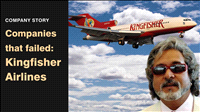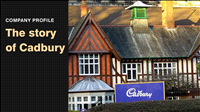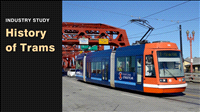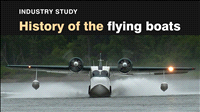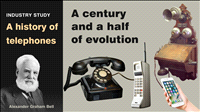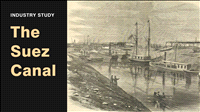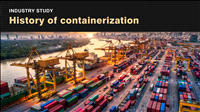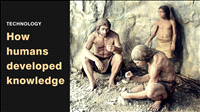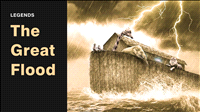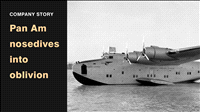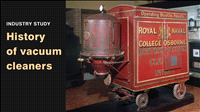Vijay Mallya’s Kingfisher Airlines | Companies that failed | Company story
By Aniket Gupta | 09 Nov 2023
Companies that failed: Kingfisher Airlines
Hi, everyone! Welcome to the Business History Channel!
I am Sheetal Gaekwad, and the video I am presenting to you is based on a script written by Aniket Gupta; it is about Kingfisher Airlines, a company that once soared through the skies but eventually crash-landed when it started to run out of fuel.
I am sure most of our Indian audience has heard about Kingfisher and its eccentric promoter, Vijay Mallya. This video will explore the beginning, rise, and fall of the ambitious airline company created by Mallya with the aim of providing luxury air travel to Indians.
Kingfisher Airlines was conceived by none other than India’s prominent liquor tycoon, Vijay Mallya, known for his dynamism, commitment to quality, and distinctive, if a bit eccentric, and extravagant, style. He had inherited a big industrial empire from his father, Vittal Mallya, who had very carefully and systematically added one company after another to his portfolio of assets.
Vittal Mallya, being very ambitious, started acquiring shares of United Breweries Limited in 1946–47. He became the company’s first Indian director in 1947 and chairman the following year. In 1951, he acquired McDowell & Company Limited.
In 1952, he shifted his base to Bangalore and acquired small breweries and distilleries, expanding to Kerala, Andhra Pradesh, Goa, and Bihar.
In 1977, he foresaw the impact of an official prohibition drive, and acquired more breweries and distilleries. He also set up a new plant in Pondicherry, establishing himself as leader of India’s beer and liquor industry.
By 1981, Vittal Mallya’s his empire included 10 breweries, 14 distilleries, seven food companies, six investment firms, two packaging units, three drug companies, soft-drink bottling plants, a battery unit, and one styrene company. He also led other firms despite not having controlling interests in them.
Vittal Mallya passed away in October 1983 at the age of 59. That left his son Vijay, then just 28, to take over the reins of the family’s business.
Vijay Mallya had been parachuted into the role of chairman of the UB Group after his publicity-shy father, Vittal Mallya, passed away.
Under the son, the group suddenly became very high-profile. Vijay Mallya (and after this, when I say Mallya, I will mean Vijay Mallya) started to expand the company into many diverse business areas. He acquired 2 companies Berger Paints, and Best and Crompton in 1988, and Mangalore Chemicals and Fertilizers in 1990.
Mallya leveraged his popularity, bolstered the United Breweries brand, and earned the tag ‘King of Good Times’, which matched his image of a flamboyant playboy who indulged his penchant for fast cars, yachts, numerous residences in many countries, race horses, and Force India Formula 1 race team cars. On 20 February 2008, Mallya bought the Bangalore franchise of the Indian Premier League for $111.6 million and named it Royal Challengers Bangalore.
Mallya helped the group grow into a multinational conglomerate of over 60 companies. They reported an annual turnover of $11 billion in 1998–1999.
The group had breweries, distilleries, jams-and-ketchup, paints, and pharmaceutical companies in its portfolio. Under his leadership, United Spirits Ltd., the flagship company of the UB Group, achieved the milestone of selling 100 million cases, becoming the second-largest spirits company in the world by volume.
Despite all this, Vijay Mallya wanted more. And then he created Kingfisher Airlines.
So, in 2003, the United Breweries Group founded Kingfisher Airlines, which was headquartered in Bengaluru, in the state of Karnataka. The airline entered the aviation industry during a period when low-cost airlines had revolutionized the market, making air travel accessible to a wider Indian audience. Mallya wanted to ride that trend to a new high.
Kingfisher Airlines was a latecomer to the Indian aviation scene. Although the airline was established in 2003, it wasn’t until 2005 that it started flying commercially. But, typical of its promoter Vijay Mallya’s style, it wanted to be big from the word go. It became the first Indian air carrier to place orders for Airbus A380 aircraft. The bill amounted to $3 billion.
On 9 May 2005, Kingfisher Airlines started its commercial journey with a fleet of four new Airbus A320-200s, which operated daily flights between Mumbai and Delhi. The company’s mission was to deliver world-class services and surpass the competition in both product quality and service excellence.
To succeed in this mission, the aircraft were equipped with state-of-the-art facilities and exceptional amenities such as hot meals, comfortable seating, personalized in-flight entertainment, and a guest-centric approach.
Kingfisher’s next fleet of four daily flights were launched between Bangalore and Delhi. The airline rapidly expanded its service to 104 flights per day, connecting 16 cities in one year by introducing 17 aircraft. During 2005–2007, Kingfisher set a record for the fastest aircraft induction.
Since its introduction, Kingfisher Airlines became very popular among business-class travelers. Vijay Mallya’s idea of providing luxurious amenities started to look like a genius idea. In 2008, the company gained recognition as the sole five-star airline in India, earning a reputation for delivering exceptional flight services to its passengers.
This recognition boosted Vijay Mallya’s confidence, and he then took an ambitious leap to start international flight travel with Kingfisher Airlines. On 3 September 2008, Kingfisher inaugurated its first international route from Bengaluru to London.
By 2009, Kingfisher had garnered widespread acclaim globally and was among the seven select airlines worldwide awarded a coveted 5-star rating by Skytrax.
Gradually, it emerged as the largest airline in India, commanding a 26.7% share of the aviation market and operating approximately 250 daily flights. In May 2009, Kingfisher Airlines achieved the highest market share among all airlines in India by carrying over 1 million passengers.
Then, Kingfisher decided to cater to a diverse range of passengers and hence decided to create three different classes in their airline.
This transition took place in 2009. Kingfisher started different classes of airlines that catered to a diverse range of travellers, including businessmen, common middle-class people, etc. Kingfisher assumed that passengers could now have a clear image in their minds of which class of ticket they needed to book according to their budget.
The first class was named Kingfisher First. It targeted business-class travellers with high travel budgets seeking premium services.
Then Kingfisher decided to create Kingfisher Class. This was a premium economy service designed for trendy and upwardly mobile middle-class passengers.
Finally, they created Kingfisher Red. This was a low-fare basic class, essentially a rebranding of Air Deccan, acquired in 2007, to suit price-conscious middle-class passengers.
In 2011, Kingfisher Airlines received the distinction of being named the best Indian airline of the year.
It seemed like Kingfisher would etch its name as one of the most successful airline companies in India for perpetuity. But that was not to happen. The company’s problems started.
Kingfisher’s hasty acquisition of Air Deccan, a low-cost carrier founded by Capt. G.R. Gopinath, resulted in giving out mixed signals.
You see, Kingfisher had built its reputation as a high-cost carrier that emphasized luxury. Air Deccan was the complete opposite of this, as they provided low-cost and affordable air tickets so every Indian could travel by air.
You may wonder why, when everything was going smoothly, Kingfisher felt the need to go and acquire Air Deccan.
Let me tell you, Kingfisher had not one but two reasons behind the merger.
The first reason was to create a stronger financial position in the aviation market. Air Deccan was already an established airline in the domestic markets; hence, Kingfisher thought that acquiring it would be a good idea financially.
The second reason was more important for Kingfisher. As mentioned earlier, Kingfisher wanted to start international travel, but by law it was required to have at least five years’ experience in the domestic aviation market before it could venture into an international service.
Kingfisher lacked this experience. But, as Vijay Mallya wanted things to happen as soon as possible, he decided to acquire Air Deccan, which had the required experience. Kingfisher then renamed Air Deccan as Kingfisher Red and reserved it for the domestic market.
Ironically, this move, which was supposed to make the group financially stronger, ended up being one of the main reasons for the airline's ultimate demise.
The early signs of this merger being a bad business deal started to show when Kingfisher started to lose some frequent travelers. The main reason reported behind this was the confusion that was created after the launch of Kingfisher Red.
Kingfisher Airlines passengers were accustomed to luxury offerings, such as gourmet cuisine and lounge access, which were now replaced with the budget-oriented approach of Air Deccan. This merger started to stain the premium brand status of Kingfisher.
The next three years proved to be really tough for Kingfisher Airlines, as they incurred losses exceeding 10 billion rupees.
Kingfisher did realize the error in acquiring Air Deccan, and it attempted to rectify the situation by raising the price of Kingfisher Red tickets. Unfortunately, this last-ditch effort did not help.
The downslide had already started. The company reported losses of Rs. 1,000 crore for three consecutive years. And by 2012, its losses had mounted to over Rs. 7,000 crore, and half its aircraft were grounded.
The low-cost Kingfisher Red ceased to exist by February 2011, and its employees were not getting salaries. They went on strike.
Soon, the entire operation came to a halt.
This merger was not the only reason behind the downfall of Kingfisher Airlines. Many aviation experts and trade analysts also blame the top management of Kingfisher Airlines for some poor decisions, such as the hasty acquisition of Air Deccan, which led to the insurmountable losses.
In 2012, the aviation industry was also trying to compete with rising fuel prices. Kingfisher was no exception to this. Unfortunately for it, they struggled to meet their fuel payments and started to test the patience of fuel vendors. One such vendor, Bharat Petroleum Corporation, filed a case against the airline in the Bangalore High Court.
Even keeping in mind the fact that the market conditions of the aviation industry were harsh back in 2012, there were some business decisions that Kingfisher made that had a deeper impact.
Mallya viewed airlines as a mode of luxury travel. He created his whole business model around the themes of premium and luxury. But he forgot that transportation in India is considered a necessity rather than a luxury. Hence, only a select class of passengers was willing to pay extra for luxury.
Unfortunately, Vijay Mallya failed to recognize the distinction between the liquor and aviation industries. He assumed that since customers were willing to pay extra for premium alcohol, the same would hold true for air travel. Which was far from the truth.
Mallya was also involved in various other businesses. Although his liquor business had a strong foundation and some capable officials were appointed to run the business, the airline was left to function largely on its own. The airline business required more focused attention from Mallya, which it did not receive.
Kingfisher Airlines operated a total of 366 domestic flights and 20 international flights, and the airline possessed a fleet of 67 aircraft. This extensive aircraft ownership resulted in substantial aircraft lease rental costs. In 2011, these lease rental expenses reached a staggering Rs.984 crore, causing 66 of the aircraft to be grounded.
Kingfisher Airlines also faced problems paying employees’ salaries in 2011. It was reported that employees had not received 4 to 5 months of salary. In response, Kingfisher employees refused to sign ‘tech logs’ – documents certifying the aircrafts’ fitness and readiness for flight.
This turned out to be disastrous for Kingfisher, as this action was noticed by the Directorate General of Civil Aviation, and on 20 December 2012, the directorate revoked Kingfisher Airlines’ operating license. Kingfisher Airlines had to halt all operations.
In December 2011, the income tax department froze Kingfisher Airlines’ bank accounts because of outstanding arrears of Rs. 70 crore.
With the debts mounting and operational services being suspended, Kingfisher Airlines now stood on the brink of extinction.
Vijay Mallya had looked for help in other places. He approached several banks for loans.
The Indian Express published a report in November 2015, which stated that Mallya incurred a total loss of Rs 9,091.40 crore and had taken loans from 17 banks.
His most substantial debt, amounting to Rs. 1,600 crore, was owed to the State Bank of India. The airline also had outstanding debts of Rs. 800 crore each to Punjab National Bank and IDBI Bank, Rs. 650 crore to Bank of India, Rs. 550 crore to Bank of Baroda, Rs. 410 crore to Central Bank, Rs. 320 crore to UCO Bank, Rs. 310 crore to Corporation Bank, and Rs. 430 crore to United Bank of India, among others.
Today, Vijay Mallya still owes large debts to the majority of these banks. And he has a lot of cases pending in different courts both in India and in the UK. He resides in the UK, out of reach of Indian officials, and of any court of law that could have indicted him.
Kingfisher Airlines, which has now gone out of business, finds itself burdened with a total debt of Rs. 7,057.08 crore ($1.414 billion) and total losses amounting to Rs. 6,000 crore ($1.2 billion).
The Indian airline scene has been going through some serious changes, and it's not slowing down anytime soon. Some airlines have thrived while others have bit the dust in this cutthroat industry. Kingfisher Airlines, Vijay Mallya's big dream that started strong turned into a colossal mess.
It might be argued that instead of making the airline a money-spinner, Mallya was more interested in building a flashy image. The group went all out with fancy designs, top-notch food, and a posh atmosphere, not to mention grand plans to conquer the international market.
But here's the kicker — they forgot about the regular folks flying in economy class. That was a major blunder. Mallya’s strategy was a train wreck in the long run, and it seriously jeopardized the entire aviation sector.
The lesson we learn from this disaster: If you want to make it big in business, you've got to focus on running things efficiently, making smart decisions, improving service quality, and dealing with problems expeditiously.






